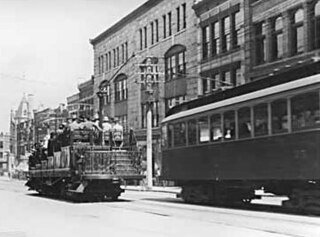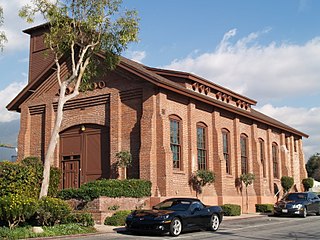
The Pacific Electric Railway Company, nicknamed the Red Cars, was a privately owned mass transit system in Southern California consisting of electrically powered streetcars, interurban cars, and buses and was the largest electric railway system in the world in the 1920s. Organized around the city centers of Los Angeles and San Bernardino, it connected cities in Los Angeles County, Orange County, San Bernardino County and Riverside County.

The interurban is a type of electric railway, with tram-like electric self-propelled railcars which run within and between cities or towns. The term "interurban" is usually used in North America, with other terms used outside it. They were very prevalent in many parts of the world before the Second World War and were used primarily for passenger travel between cities and their surrounding suburban and rural communities. Interurban as a term encompassed the companies, their infrastructure, their cars that ran on the rails, and their service. In the United States, the early 1900s interurban was a valuable economic institution, when most roads between towns, many town streets were unpaved, and transportation and haulage was by horse-drawn carriages and carts.

The British Columbia Electric Railway (BCER) was a historic railway which operated in southwestern British Columbia, Canada. Originally the parent company for, and later a division of, BC Electric Company, the BCER assumed control of existing streetcar and interurban lines in southwestern British Columbia in 1897, and operated the electric railway systems in the region until the last interurban service was discontinued in 1958. During and after the streetcar era, BC Electric also ran bus and trolleybus systems in Greater Vancouver and bus service in Greater Victoria; these systems subsequently became part of BC Transit, and the routes in Greater Vancouver eventually came under the control of TransLink. Trolley buses still run in the City of Vancouver with one line extending into Burnaby.

The Grand River Railway was an interurban electric railway in what is now the Regional Municipality of Waterloo, in Southwestern Ontario, Canada.
The Hamilton, Grimsby and Beamsville Electric Railway (HG&B) was an interurban railway that operated between Hamilton and Vineland in the Niagara Peninsula in Ontario, Canada. It was incorporated in 1894.

Pacific Electric Railway Company Substation No. 8, also known as the Altadena Substation, is a former traction substation in Altadena, California. It operated under the Pacific Electric Railway and served as the substation for Pasadena area lines.
The Annandale Line was an interurban route operated by the Pacific Electric Railway from 1902 to 1928.
Interurban Press was a small, privately owned American publishing company, specializing in books about streetcars, other forms of rail transit and railroads in North America, from 1943 until 1993. It was based in the Los Angeles area, and specifically in Glendale, California after 1976. Although its primary focus was on books, it also published three magazines starting in the 1980s, along with videos and calendars. At its peak, the company employed 10 people and generated about $2 million in business annually.

The Sierra Vista Line was a streetcar route mostly operated by the Pacific Electric Railway. It ran from 1895 to 1951 as the short turn making local stops along the Pasadena Short Line on the outside tracks of the Northern Division quadruple-track system.

Plano Station, Texas Electric Railway, now known as the Interurban Railway Museum, is a historic train station at 901 E 15th Street in Plano, Texas. It is still served by the Downtown Plano station of the Dallas Area Rapid Transit light rail, which reutilized the right of way of the interurban.

The Lake Erie and Northern Railway was an interurban electric railway which operated in the Grand River Valley in Ontario, Canada. The railway owned and operated a north–south mainline which ran from Galt in the north to Port Dover on the shore of Lake Erie in the south. Along the way, it ran through rural areas of Waterloo County, Brant County, and Norfolk County, as well as the city of Brantford, where it had an interchange with the Brantford and Hamilton Electric Railway. Construction on the mainline began in 1913. The railway began operations in 1916 as a subsidiary of the Canadian Pacific Railway (CPR), which had purchased the line before construction had finished. In 1931, it was consolidated with the Grand River Railway under a single CPR subsidiary, the Canadian Pacific Electric Lines (CPEL), which managed both interurban railways, though they continued to exist as legally separate entities. Passenger service was discontinued in 1955 but electric freight operations continued until 1961, when the LE&N's electric locomotives were replaced by diesel CPR locomotives and the line was de-electrified. In the same year, service on the mainline from Simcoe to Port Dover was discontinued, but the remainder continued to operate as a branchline which as early as 1975 was known as the CP Simcoe Subdivision. The remainder of the line was officially abandoned in the early 1990s, ending almost seventy-five years of operation.

The Brush Canyon Line was a short-lived Pacific Electric streetcar branch line in Los Angeles. Brush Canyon is now generally known as Bronson Canyon.

The Arrowhead Line was a suburban route of the Pacific Electric Railway. It ran from the joint Pacific Electric and Southern Pacific San Bernardino Depot to Arrowhead Springs, by way of D Street.

The Shorb Line is a former Pacific Electric interurban railway line in Los Angeles County, California. Unlike most of the company's services, trains did not travel to Downtown Los Angeles and instead provided a suburban service between Pasadena and the transcontinental Southern Pacific railway at Alhambra.

The Redlands Line is a former Pacific Electric interurban railway line in the Inland Empire. The route provided suburban service between San Bernardino and Redlands.

The Upland–Ontario Line is a former Pacific Electric streetcar line in San Bernardino County, California. Cars did not travel to Downtown Los Angeles and instead provided a local service between Ontario and Upland with through service to Pomona.

The Santa Ana–Huntington Beach Line is a former Pacific Electric interurban railway line in Orange County, California. A single car provided a suburban service between Huntington Beach and the sugar refineries in La Bolsa.
The Highland Line was a 6.56-mile (10.56 km) local streetcar route of the Pacific Electric Railway. It ran from the San Bernardino Depot to Highland. A short branch line served the Southern California State Asylum for the Insane and Inebriates at Patton.

The Venice Boulevard Line was a local streetcar line of the Pacific Electric. It operated between Downtown Los Angeles and Vineyard Junction, where riders could transfer to interurban cars. Nearly all Venice Short Line cars did not accept local passengers, leaving this as the primary streetcar service along its namesake boulevard.








